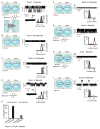Piezo1 Channels Are Inherently Mechanosensitive
- PMID: 27829145
- PMCID: PMC5129625
- DOI: 10.1016/j.celrep.2016.10.033
Piezo1 Channels Are Inherently Mechanosensitive
Abstract
The conversion of mechanical force to chemical signals is critical for many biological processes, including the senses of touch, pain, and hearing. Mechanosensitive ion channels play a key role in sensing the mechanical stimuli experienced by various cell types and are present in organisms from bacteria to mammals. Bacterial mechanosensitive channels are characterized thoroughly, but less is known about their counterparts in vertebrates. Piezos have been recently established as ion channels required for mechanotransduction in disparate cell types in vitro and in vivo. Overexpression of Piezos in heterologous cells gives rise to large mechanically activated currents; however, it is unclear whether Piezos are inherently mechanosensitive or rely on alternate cellular components to sense mechanical stimuli. Here, we show that mechanical perturbations of the lipid bilayer alone are sufficient to activate Piezo channels, illustrating their innate ability as molecular force transducers.
Keywords: Piezo1; lipid bilayer; mechanosensitive ion channel; mechanotransduction; membrane asymmetry; membrane tension.
Copyright © 2016 The Authors. Published by Elsevier Inc. All rights reserved.
Conflict of interest statement
Author Information: The authors declare no competing interests.
Figures



References
-
- Árnadóttir J, Chalfie M. Eukaryotic Mechanosensitive Channels. Annu Rev Biophys. 2010;39:111–137. - PubMed
-
- Bass RB, Strop P, Barclay M, Rees DC. Crystal structure of Escherichia coli MscS, a voltage-modulated and mechanosensitive channel. Science. 2002;298:1582–1587. - PubMed
-
- Battle AR, Petrov E, Pal P, Martinac B. Rapid and improved reconstitution of bacterial mechanosensitive ion channel proteins MscS and MscL into liposomes using a modified sucrose method. FEBS Lett. 2009;583:407–412. - PubMed
Publication types
MeSH terms
Substances
Grants and funding
LinkOut - more resources
Full Text Sources
Other Literature Sources

